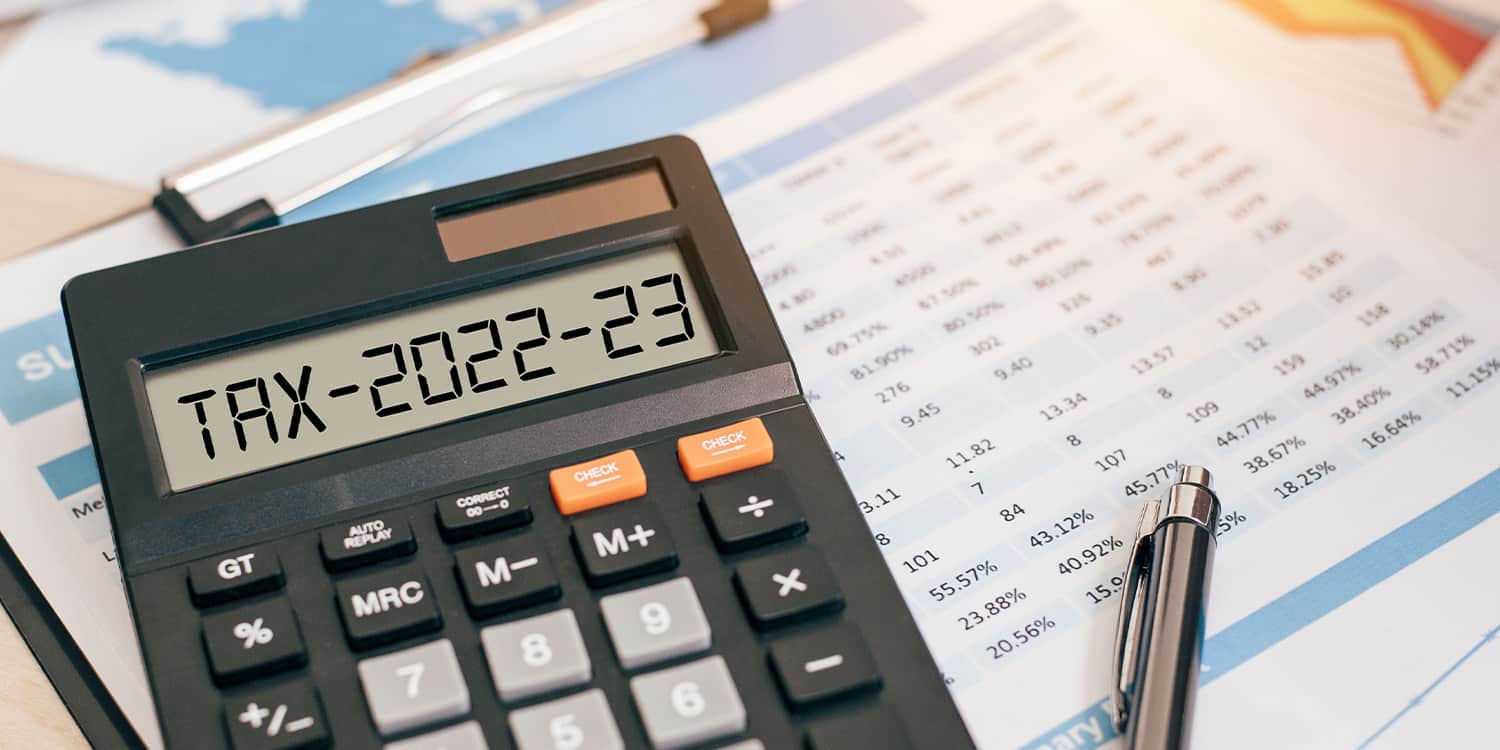The new tax year arrived on 6 April 2023. Like many business owners, you may have been too busy to make the necessary preparations or even think about what that entails. But don’t worry – that’s what we’re here for. Read on to find out what changes the new 2023-24 tax year brings.
Key changes for the new tax year – 2023-24
The most notable changes for the new tax year are Corporation Tax rates, the halving of the annual dividend allowance, and the lowering of the additional-rate Income Tax threshold.
These adjustments will affect many limited company directors and shareholders, in addition to approximately 250,000 top earners in the UK.
The rates of Income Tax remain the same for England & Wales and Northern Ireland, but there have been some adjustments to Scottish Income Tax higher and top rates.
Other than a 30p/week increase to Class 2 National Insurance contributions, no other changes to National Insurance have taken place.
VAT rates and thresholds remain unchanged, which is good news for VAT-registered businesses.
Corporation Tax
On 1 April 2023, the main rate of Corporation Tax increased from 19% to 25%. The rate now applies to all profits generated by companies with annual profits over £250,000.
A small profits rate of 19% now applies only to companies with profits up to £50,000.
Companies with profits between the small profits rate (£50,000) and the main rate (£250,000) will pay tax at 25% reduced by a ‘Marginal Relief‘, which provides a gradual increase in the effective Corporation Tax rate.
Dividend allowance
The dividend allowance for the 2023-24 tax year has been halved and is now just £1,000. From April 2024, it will be reduced again to £500. The rates of dividend tax, however, remain the same: 8.75% basic rate, 33.75% higher rate, and 39.35% additional rate.
Income Tax
There are no changes to Income Tax rates in England & Wales and Northern Ireland for the new tax year. However, the additional-rate Income Tax threshold has been lowered from £150,000 to £125,140. There have also been some adjustments to the higher rate and top rate of Scottish Income Tax.
The tables below illustrate the rates and thresholds for 2023-24.
Income Tax bands and thresholds in England & Wales and Northern Ireland
| Income Tax band | 2023-24 thresholds | 2022-23 thresholds |
| 0% (Personal Allowance) | Up to £12,570 | Up to £12,570 |
| 20% (Basic rate) | £12,571 to £50,270 | £12,571 to £50,270 |
| 40% (Higher rate) | £50,271 to £125,140 | £50,271 to £150,000 |
| 45% (Additional rate) | Over £125,140 | Over £150,000 |
Income Tax bands and thresholds in Scotland
| Income Tax band | 2023-24 thresholds | 2022-23 thresholds |
| 0% (Personal Allowance) | Up to £12,570 | Up to £12,570 |
| 19% (Starter rate) | £12,571 to £14,732 | £12,571 to £14,667 |
| 20% (Basic rate) | £14,733 to £25,688 | £14,668 to £25,296 |
| 21% (Intermediate rate) | £25,689 to £43,662 | £25,297 to £43,662 |
| 42% (Higher rate) | £43,663 to £125,140 | (41%) £43,663 to £150,000 |
| 47% (Top rate) | Over £125,140 | (46%) Over £150,000 |
National Insurance contributions (NICs)
Class 1 National Insurance contributions (NICs) are paid by employees (on their wages) and employers (on their employees’ wages). For 2023-24, the main rates of National Insurance remain unchanged – 12% for employees and 13.8% for employers.
Similarly, there are no changes to Class 4 National Insurance for those who pay taxes through Self Assessment, including sole traders, members of partnerships and LLPs, and limited company shareholders. The Class 4 main rates remain at 9% and 2%, but Class 2 contributions have risen from £3.15 per week to £3.45 per week.
The table below sets out the National Insurance rates and thresholds for the new tax year 2023-24 compared to 2022-23
Class 1 National Insurance rates and thresholds
| 2023-24 | 2022-23 | |
| Employees Class 1 NICs | 12% on earnings between Primary Threshold (PT) and Upper Earnings Limit (UEL)
2% on earnings above UEL |
From 6 April to 5 November 2022:
13.25% between PT and UEL 3.25% on earnings above UEL From 6 November 2022 to April 5 2023: 12% on earnings between PT and UEL 2% on earnings above UEL |
| Employer Class 1 NICs | 13.8% on employees’ wages above the Secondary Threshold (ST) | From 6 April 2022 to 5 November 2022:
15.05% on employees’ wages above the ST From 6 November 2022 to 5 April 2023: 13.8% on employees’ wages above the ST |
| Lower Earnings Limit (LEL) | £123 per week
£533 per month £6,396 per year |
£123 per week
£533 per month £6,396 per year |
| Primary Threshold (PT) | 242 per week
£1,048 per month £12,570 per year |
£11,908 annualised threshold, as a result of mid-year adjustments shown below.
From 6 April to 5 November 2022: £190 per week £823 per month £9,880 per year From 6 November 2022 to 5 April 2023: £242 per week £1,048 per month £12,570 per year |
| Secondary Threshold (ST) | £175 per week
£758 per month £9,100 per year |
£175 per week
£758 per month £9,100 per year |
| Upper Earnings Limit (UEL) | £967 per week
£4,189 per month £50,270 per year |
£967 per week
£4,189 per month £50,270 per year |
Class 2 and Class 4 National Insurance rates and thresholds
| 2023-24 | 2022-23 | |
| Class 2 | £3.45 per week when profits exceed Lower Profits Threshold (LPT) of £12,570/year | £3.15 per week when profits exceed LPT of £11,908/year |
| Class 4 | 9% on profits between Lower Profits Limit (LPL) and Upper Profits Limit (UPL)
2% on profits above UPL |
9.73% on profits between LPL and UPL
2.73% on profits above UPL |
| Small Profits Threshold (SPT) | £6,725 per year | £6,725 per year |
| Lower Profits Limit (LPL) | £12,570 | £11,908 annualised LPL, as a result of mid-year adjustments shown below.
From 6 April to 5 November 2022: £9,880 per year From 6 November 2022 to 5 April 2023 £12,570 per year |
| Upper Profits Limit (UPL) | £50,270 | £50,270 |
Tax on dividends
The annual tax-free dividend allowance for the new tax year has been reduced from £2,000 to £1,000. As a result, limited company shareholders will pay more slightly more tax on dividend income from shares.
The table below outlines the rates for the current and previous tax years, in accordance with the Income Tax band(s) applicable to your annual earnings. These rates apply to taxpayers in England & Wales, Scotland, and Northern Ireland.
Whilst Income Tax in Scotland is different from the rest of the UK, dividend tax for Scottish taxpayers is worked out in accordance with Income Tax bands and thresholds that apply to the rest of the UK.
| Tax band | 2022-23 | 2022-23 |
| Within Personal Allowance | 0% | 0% |
| Basic rate taxpayer | 8.75% | 8.75% |
| Higher rate taxpayer | 33.75% | 33.75% |
| Additional rate taxpayer | 39.35% | 39.35% |
Employment Allowance
The annual Employment Allowance remains at £5,000 for the new tax year.
National Minimum Wage
On 1 April, the National Minimum Wage (NMW) was increased from £9.50 per hour to £10.42 per hour for workers aged 23 and over. Different hourly rates apply to those aged 21 to 22 years (£10.18), 18 to 20 years (£7.49), and under 18 years and apprentices (£5.28).
If you pay any of your employees the minimum wage, you will need to make the necessary adjustments to your payroll to reflect the new higher rates of pay.
Statutory Pay for employees
On 2 April, statutory pay for parents increases from £156.66. per week to 172.48/week. This applies to Statutory Maternity, Paternity, Adoption, Shared Parental, Parental Bereavement Pay, and Maternity Allowance. Maternity Allowance will change from £96.35 per week to £99.35 per week.
Statutory Sick Pay (SSP) will also increase from £99.35 per week to £109.40 per week. If you’re an employer, this is the minimum amount of sick pay that you must pay to eligible employees and workers.
Value Added Tax (VAT)
VAT remains unchanged for the 2023-24 tax year, with the registration threshold staying at £85,000.
Thanks for reading
So, there you have it. We have covered the new tax year changes you need to know about for your business and personal tax. We hope you have found this post helpful. Please leave a comment if you have any questions.









Thank you for this insightful overview of the key changes in the 2023-24 tax year. As a small business owner, staying informed about these adjustments is crucial for making informed financial decisions. The detailed breakdown of Corporation Tax rate changes, the dividend allowance reduction, and the Income Tax band adjustments provides a clear understanding of how these modifications may impact businesses of different sizes.
I appreciate the clarity in presenting the information, especially regarding National Insurance contributions and VAT rates, as these are areas that directly affect my business operations. The inclusion of changes in National Minimum Wage, statutory pay, and the reminder about the Employment Allowance is a helpful touch, underlining the holistic approach of the post in covering various aspects of financial implications for businesses.
Your blog has become a go-to resource for me when it comes to staying abreast of tax-related updates. It not only helps me comply with regulatory changes but also aids in strategic planning for the financial well-being of my business. Keep up the excellent work!
Thank you for your kind words, Steve.
Kind regards,
The 1st Formations Team
This blog was… how do you say it? Relevant!! Finally I’ve found something that helped me. Thank you!
We’re glad you found this blog to be relevant to what you were looking for, Darlene.
Kind regards,
The 1st Formations Team
Thank you for making it much easier to understand taxes and the new changes. This is such a useful blog post!
Hi Emine
Thank you for your comment. We are glad you found it helpful.
Best regards,
The 1st Formations Team
Thank you for providing the Table with National Insurance rates and thresholds. This is easily the most straightforward blog post I’ve read about it!
Hi Amelia
Thank you for your kind comment. Your praise is greatly appreciated!
Best regards,
The 1st Formations Team
In the long run, would it benefit me to incorporate my business instead of operating as a sole trader? I sole trade currently and business revenues will affect what tax band I’m under based on the new rules.
Hi Angus
Thank you for your comment.
With regards to your question sole trader vs limited company – we would recommend a limited company as a trading vehicle for several reasons other than tax, e.g. limited liability, reputational benefits, etc.
Please have a look at our YouTube video: Limited company or sole trader? We help you decide.
Best regards,
The 1st Formations Team
Great blog! Really informative
Hi Osman
Thank you for your kind words – we are happy you found this blog helpful.
Best regards,
The 1st Formations Team
This can be so confusing, but 1st Formations have made everything so easy to understand, once again! Thank you!
Hi Sophia
Thank you for your lovely comment – most appreciated.
Best regards,
The 1st Formations Team